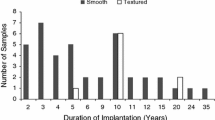Summary
Contraction of the fibrous capsule around an implant after prosthetic breast surgery is a serious complication, which can adversely effect the outcome and spoil the overall result. Textured silicone implants are reported to have reduced rates of capsular contraction, but their exact mechanism, especially at the interface, remains unclear. Over a period of 21/2 years, 94 textured silicone implants were used in augmentation mammoplasty. A follow-up examination was possible in 74 cases. The clinical assessment of results was based on Baker's classification. In addition to the subjective assessment of breast firmness, objective measurements (mamma compliance) were obtained. The average follow-up period was 55.6 weeks. 79.7% of augmented breasts were classified as Baker I, 16.2% as Baker II, 4.1% as Baker III and 0% Baker IV In comparison to previous results reported in the literature, the incidence of capsular contracture obtained with textured implants was significantly lower. All Baker III cases were replacements of the original implant following advanced capsular contraction. The compliance measurements were found to correlate well with Baker's classification. Sixty-one of 72 cases of augmented breasts showed compliance values similar to normal breasts, which ranged between 0.64 and 3.7 cm at D20n. This measurement proves that 82.4% of the augmented breasts are as soft as normal breasts. A partial comparison between our clinical data and histological examination was possible. Firm adhesion of the capsule to the surface of the implant was characteristic of those breasts which showed no capsular contracture, while in breasts showing advanced capsular contraction, implant and capsule were separated by a liquid film. The use of surface textured silicone implants has led to a significantly decreased rate of capsular contraction without having to employ steroids. Close contact between implant and capsule seems to be the most important factor for reduced capsular contraction.
Similar content being viewed by others
References
Baker JL (1978) Augmentation mammoplasty. In: Owsley JQ, Peterson RA (eds) Symposium on aesthetic surgery of the breast. Mosby, St Louis, p 272
Biggs TM, Cukier J, Worthing LF (1982) Augmentation mammaplasty: a review of 18 years. Plast Reconstr Surg 69:445
Burkhardt BR, Schnur PL, Tofield JJ, Dempsey PD (1982) Objective clinical assessment of fibrous capsular contracture. Plast Reconstr Surg 69:794
Burkhardt BR et al (1986) Capsular contraction: a prospective study of the effect of local antibacterial agents. Plast Reconstr Surg 77:919
Courtiss H (1979) The fate of breast implants with infections around them. Plast Reconstr Surg 63:813
Cronin TD, Gerow FJ (1964) Augmentation mammoplasty: a new “natural feel” prosthesis. In: Transactions of the third international congress of plastic surgery. Excerpta Medica International Congress Series, No. 66. Excerpta Medica, Amsterdam, p 41
Cronin TD, Persoff MM, Upton J (1978) Augmentation mammoplasty: complications and etiology. In: Owsley JQ Jr, Peterson RA (eds) Symposium on aesthetic surgery of the breast. Mosby, St Louis, p 272
Gylbert L, Asplund O, Jurell G (1990) Capsular contraction after breast reconstruction with silicone gel and saline filled implants: a 6-year follow-up. Plast Reconstr Surg 85:373
Hipps ChJ, Raju DR, Straith RE (1978) Influence of some operative and postoperative factors on capsular contracture around breast prosthesis. Plast Reconstr Surg 61:384
Hoflehner H, Pierer G, Rehak P (1993) Mamma compliance — an objective technique for measuring capsular fibrosis. Plast Reconstr Surg 92:1078
McCurdy JA (1989) Capsular contraction following augmentation mammoplasty: etiology, management and prevention. Am J Cosm Surg 6:141
McGrath MH, Burkhardt BR (1984) The safety and efficacy of breast implants for augmentation mammaplasty. Plast Reconstr Surg 74:550
Little G, Baker JL (1980) Results of closed compression capsulotomy for treatment of contracted breast. Plast Reconstr Surg 65:30
Pierer G, Hoflehner H, Rehak P, Hellbom B, Scharnagl E, Deutschmann W (1991) Elektronische Kompressibilitätsmessung der Mamma — Ein neues Verfahren zur Objektivierung der Kapselfibrose. Abstraktband, 29. Jahrestagung der Österreichischen Gesellschaft fur Plastische, Ästhetische und Rekonstruktive Chirurgie
Watson J (1976) Some observations on breast augmentation procedures over the past two decades. Aesthet Plast Surg 1:89
Author information
Authors and Affiliations
Rights and permissions
About this article
Cite this article
Hoflehner, H., Pierer, G., Ratschek, M. et al. Subjective and objective assessment of capsular contracture. Eur J Plast Surg 17, 69–74 (1994). https://doi.org/10.1007/BF00176918
Issue Date:
DOI: https://doi.org/10.1007/BF00176918




